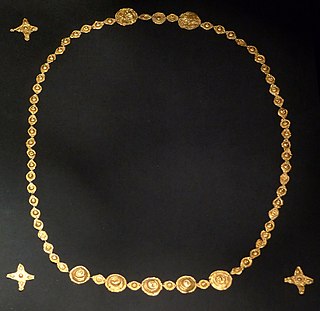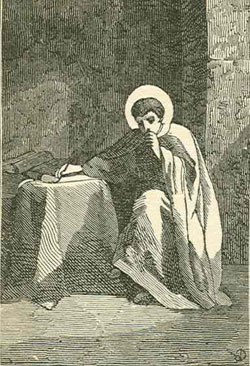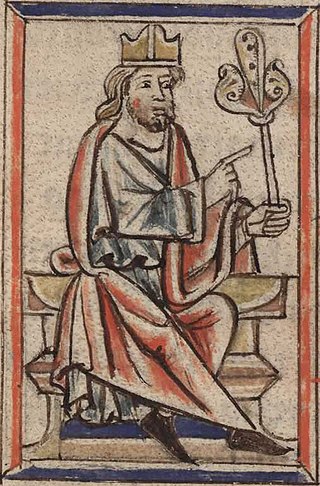Related Research Articles

Year 549 (DXLIX) was a common year starting on Friday of the Julian calendar. The denomination 549 for this year has been used since the early medieval period, when the Anno Domini calendar era became the prevalent method in Europe for naming years.

The Vandals were a Germanic people who were first reported in the written records as inhabitants of what is now Poland, during the period of the Roman empire. Much later, in the fifth century, a group of Vandals led by kings established Vandal kingdoms first within the Iberian Peninsula, and then in the western Mediterranean islands, and North Africa.

Gordian II was Roman emperor with his father Gordian I in 238 AD, the Year of the Six Emperors. Seeking to overthrow Maximinus Thrax, he died in battle outside Carthage. Since he died before his father, Gordian II had the 2nd shortest reign of any Roman emperor, at about 22 days.
Theodore of Tarsus was Archbishop of Canterbury from 668 to 690. Theodore grew up in Tarsus, but fled to Constantinople after the Persian Empire conquered Tarsus and other cities. After studying there, he relocated to Rome and was later installed as the Archbishop of Canterbury on the orders of Pope Vitalian. Accounts of his life appear in two 8th-century texts. Theodore is best known for his reform of the English Church and establishment of a school in Canterbury.

Prosper of Aquitaine, also called Prosper Tiro, was a Christian writer and disciple of Augustine of Hippo, and the first continuator of Jerome's Universal Chronicle. Particularly, Prosper is identified with the (later) axiom 'lex orandi, lex credendi, lex vivendi'—'the law [or those things] we pray is the law we believe is the law we live.'

Marcus Clodius Pupienus Maximus was Roman emperor with Balbinus for 99 days in 238, during the Year of the Six Emperors. The sources for this period are scant, and thus knowledge of the emperor is limited. In most contemporary texts he is referred to by his cognomen "Maximus" rather than by his second nomen Pupienus.
The Laterculus Veronensis or Verona List is a list of Roman provinces and barbarian peoples from the time of the emperors Diocletian and Constantine I, most likely from AD 314.

Hermeric was the king of the Suevi from at least 419 and possibly as early as 406 until his abdication in 438.

The sack of Rome in 455, was carried out by the Vandals led by their king Gaiseric.
Victor of Tunnuna was Bishop of the North African town of Tunnuna and a chronicler from Late antiquity. He was also considered a martyr by Isidore of Seville.
The Chronica Gallica of 452, also called the Gallic Chronicle of 452, is a Latin chronicle of Late Antiquity, presented in the form of annals, which continues that of Jerome. It was edited by Theodor Mommsen in the Monumenta Germaniae Historica as Chronica Gallica A. CCCCLII, along with another anonymous Gallic chronicle, the Chronica Gallica of 511.
The Historia de regibus Gothorum, Vandalorum et Suevorum is a Latin history of the Goths from 265 to 624, written by Isidore of Seville. It is a condensed account and, due to its diverse sources, somewhat inconsistent. The history of the Vandals is appended after that of the Goths, followed by a separate history of the Suevi.

Theodoric I was the king of the Visigoths from 418 to 451. Theodoric is famous for his part in stopping Attila the Hun at the Battle of the Catalaunian Plains in 451, where he was killed.
Flavius Merobaudes was a Roman army officer of Frankish origin. He was appointed magister peditum around 375, and consul twice in 377 and 383. Ancient sources record that he was put to death that year for his support of the imperial usurper Magnus Maximus, but an inscription records that he became consul a third time in 388.

Gaiseric, also known as Geiseric or Genseric was king of the Vandals and Alans from 428 to 477. He ruled over a kingdom and played a key role in the decline of the Western Roman Empire during the 5th century.
Augustalis was the first bishop of Toulon, according to some authorities. He was appointed in 441. He attended the Council of Orange that year, and the Council of Vaison the following. He is associated with the civitas of Arles by the Martyrologium Hieronymianum, which honors him on September 7. He is also named by the Martyrologium romanum on that day, with his location noted as in Gallia. An Augustalis, most likely this man, appears among a group of bishops addressed by Pope Leo I in letters dated 22 August 449 and 5 May 450, the latter of which addresses issues of jurisdiction between Arles and Vienne.
Polemius Silvius was the author of an annotated Julian calendar that attempted to integrate the traditional Roman festival cycle with the new Christian holy days. His calendar, also referred to as a laterculus or fasti, dates to around 448–449. He was active in southeastern Gaul.

The Vandal Kingdom or Kingdom of the Vandals and Alans was a confederation of Vandals and Alans, which was a barbarian kingdom established under Gaiseric, a Vandalic warlord. It ruled parts of North Africa and the Mediterranean for 99 years from 435 to 534 AD.

Roland Steinacher is an Austrian historian who is Professor of Ancient History at the University of Innsbruck.
Arcadius, Paschasius, Probus and Eutychius were Chalcedonian Christian martyrs. Natives of Hispania, they became loyal counsellors of the Vandal king Gaiseric, but were ultimately proscribed, exiled, tortured and executed in 437 for refusing the king's command to convert to Arianism. Their story is recounted in the contemporary chronicle of Prosper of Aquitaine. Paschasius and Eutychius, whose name is sometimes given as Eutychian, were brothers.
References
- ↑ The original meaning of laterculus in Classical Latin was "brick" or "tile."
- ↑ Sara Elise Phang, The Marriage of Roman Soldiers (13 B.C.-A.D. 235): Law and Family in the Imperial Army (Brill, 2001), pp. 313, 326.
- ↑ Duncan Fishwick, Imperial Cult in the Latin West (Brill, 1990), vol. 2.1, p. 441 online. For further examples, see for instance Brambach's Corpus Inscriptionum Rhenarum online passim.
- ↑ Anthony Grafton, Joseph Scaliger: A Study in the History of Classical Scholarship (Oxford University Press, 1993), p. 331.
- ↑ Jane Stevenson, The 'Laterculus Malalianus' and the School of Archbishop Theodore (Cambridge University Press, 1995), p. 1.
- ↑ Isidore, Etymologies 6.17: quod ordinem habeat stratum annorum; Grafton, Joseph Scaliger, p. 331 online.
- ↑ Stevenson, The 'Laterculus Malalianus', pp. 1–3.
- ↑ MGH, AA XIII, pp. 457–60; KFHist G 6 (2016), pp. 333–79.
- ↑ John Robert Martindale, The Prosopography of the Later Roman Empire (Cambridge University Press, 1992, reprinted 2000), vol. 3, p. xxiii.
- ↑ Roland Steinacher, "The So-Called Laterculus Regum Vandalorum et Alanorum: A Sixth-Century African Addition to Prosper Tiro's Chronicle?," in Vandals, Romans, and Berbers: New Perspectives on Late Antique North Africa (Ashgate, 2004), p. 163.
- ↑ MGH, AA XIII, pp. 464–9.
- ↑ J.N. Adams, The Regional Diversification of Latin, 200 BC–AD 600 (Cambridge University Press, 2007), p. 252.